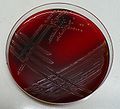Streptococcus agalactiae
Streptococcus agalactiae is Gram-positive, β-hemolytic coc. It grows in a chain-like group. On its surface it carries a group C-polysaccharide, which according to Lancefield is classified in group B (hence also called GBS - Group B Streptococcus).
Occurrence[edit | edit source]
Without clinical signs, it occurs in small amounts as a part of the physiological flora in the vagina '. Rarely, it can be isolated from the upper respiratory tract. In adults, immunocompetent individuals, the infection does not develop.
Disease[edit | edit source]
The most serious are infections of the newborn , the baby becomes infected as he passes through the birth canal from the mother. It causes severe sepsis and meningitis, often leading to death. In adults, it causes infection in immunocompromised individuals.
Risk factors[edit | edit source]
Mothers with a history of previous childbirth with early or late "Streptococcus agalactiae" disease, mothers with proven vaginal carriage "Streptococcus agalactiae" or positive "Streptococcus agalactiae" at any time in urine culture are at increased risk of neonatal disease. during pregnancy (massive settlement of the rectum and vagina is assumed).
Risk factors also include birth before the 37th week of pregnancy (immune system newborn is not sufficiently developed to fight bacteria), amniotic fluid outflow more than 18 hours before birth (it is assumed that Streptococcus agalactiae may cause premature rupture of the membrane due to protease secretion and activation of local inflammation), maternal temperature during childbirth ≥ 38 ° C (even epidural anesthesia during childbirth may increase temperature), rejection of planned incision, over 6 vaginal examinations during childbirth, young age (under 20 years), black or Hispanic birth, birth weight below 2500 g, high colonization of the newborn surface streptococci during childbirth, multiple pregnancies (if one of the children develops an infection with Streptococcus agalactiae , there is an increased risk for other children), if the result of the cultivation is unknown, missing or low titre of antibodies against the capsules Streptococcus agalactiae antigens in the mother.[1]
Laboratory diagnostics[edit | edit source]
- Cultivation
We most often cultivate on blood agar, where streptococcus grows in colonies bounded by complete hemolysis (β-hemolysis). Specifically, the so-called CAMP test can be used, where we vaccinate streptococcus with a vertical line on the golden staphylococcus vaccination line. In the positive case, butterfly hemolysis occurs at the intersection.
- Microscopy
The Gram stain method stains G + (blue), coca forming chains. Serological certificate: Surface antigen B can be detected serologically.
Therapy[edit | edit source]
Like other streptococci, Str. agalactiae is sensitive to common penicillin antibiotics, only some strains have reduced sensitivity to normal doses. In case of penicillin allergy, we administer macrolides. Resistance to tetracyclines is increasing!
Photo gallery[edit | edit source]
Summary video[edit | edit source]
<mediaplayer width='500' height='300'>https://www.youtube.com/watch?v=pR6jDZhszmk</mediaplayer>
Links[edit | edit source]
[edit | edit source]
- Streptococcal infections: Infections caused by Streptococcus agalactiae • Group A streptococcal infection • Scarlet fever • Sleep angina • Erysipel • Impetigo • Infections caused by virulent streptococci • Complications and treatment of streptococcal infections • Rheumatic fever
Reference[edit | edit source]
- HORÁČEK, Jiří, et al. Basics of medical microbiology. 1st edition. Karolinum, 2000. ISBN 80-246-0006-4 .
- Medixa. Streptococcus agalactiae [online]. [feeling. 2013-11-10]. < https://cs.medixa.org/nemoci/streptococcus-agalactiae >.




